As anyone who has visited the Old City of Israel’s capital knows, it is divided into four sections: Jewish, Muslim, Christian, and Armenian. Shlomo Deutsch explores the origins of this division, and how each quarter evolved:
The first map to include names that resemble the names of today’s four quarters (Armenian, Christian, Muslim, Jewish) was produced by the British lieutenants Edward Aldrich and Julian Simmonds in 1841, and later labeled by Rev. G. Williams in 1849. However, some of these names (Christian and Armenian) already appear in European travelers’ writings in 1806.
The Hebrew University professor Yehoshua Ben-Aryeh suggests that each religious group to move into the Old City built its community around focal points significant to its religion. . . . For Muslims, the Temple Mount, which houses the Dome of the Rock and al-Aqsa mosque, served as a major force of attraction. . . . The Christian community took root around the Church of the Holy Sepulcher.
Armenians, [the vast majority] of whom were Christian, were drawn by the Church of St. James, their most significant church in the Old City. The scope of the Armenian quarter is elusive, some defining it only as a certain walled-off area that was locked at nights.
Initially, the Jewish Quarter spanned from the “Street of the Jews” eastward to the Western Wall (excluding the adjacent Mughrabi neighborhood). . . . At the beginning of the 19th century, the Jewish quarter was almost entirely comprised of Sephardi Jews, with some 2,200 Sephardi Jews and a minimal number of Ashkenazim. Once Ashkenazim began moving in, they chose to settle near the Sephardim, holding their services in several Sephardi synagogues, including the Beit-El synagogue, until the Ashkenazi. community built the Menachem Tzion synagogue in 1837.
More about: Jerusalem, Land of Israel, Synagogues


